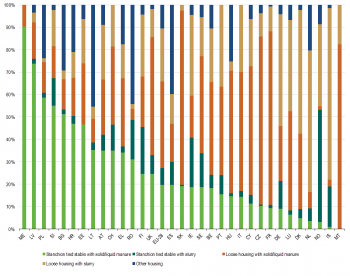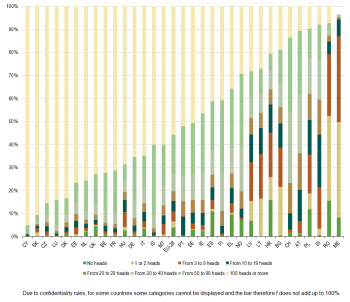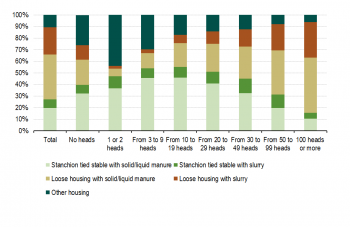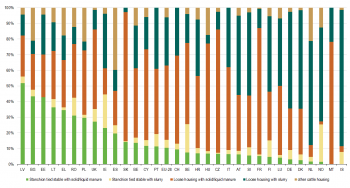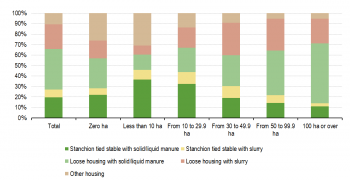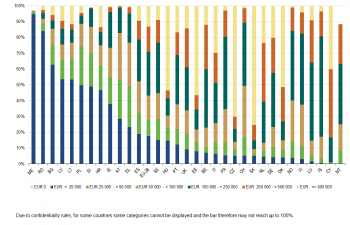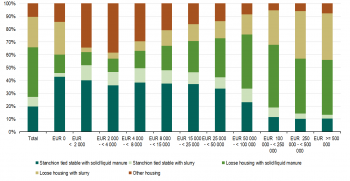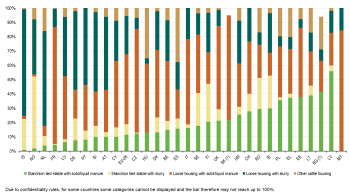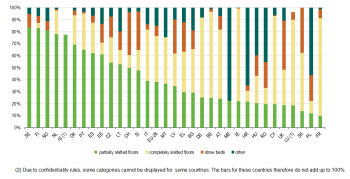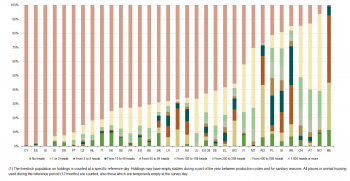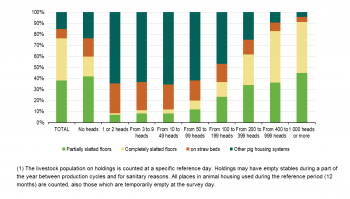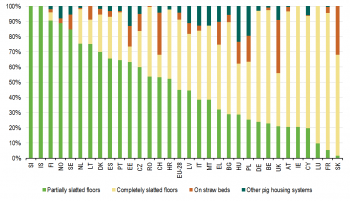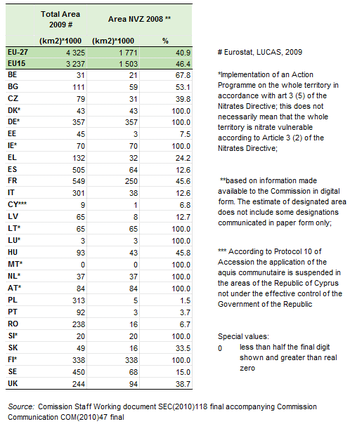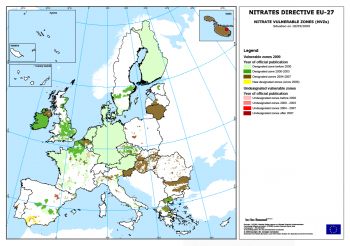- Data from February 2013. Most recent data: Further Eurostat information, Main tables and Database.
This article provides a fact sheet of the European Union (EU) agri-environmental indicator animal housing. It consists of an overview of recent data, complemented by all information on definitions, measurement methods and context needed to interpret them correctly. The animal housing article is part of a set of similar fact sheets providing a complete picture of the state of the agri-environmental indicators (AEI) in the EU.
The indicator relates to the management of manure, as do the indicators manure storage and manure application. It assesses the trends in animal housing systems. The indicator is primarily of relevance for ammonia emissions and greenhouse gas emissions.
It is measured by the following indicator:
Main indicator:
- Share of animals in different housing systems
Main statistical findings
Key messages
- In 2010 data on animal housing was collected for the first time by Eurostat from all Member States with the special survey on Agricultural Production Methods (SAPM) Survey on Agricultural Production Methods .
Assessment
Farm Structure Survey and Survey on Agricultural Production Methods
Housing systems, as they were traditionally established, provided manure consisting of faeces, urine and litter. After a more or less intensive decomposition period the manure developed into compost with stabile carbon compounds, which contribute significantly to soil fertility. A disadvantage of these solid dung systems is the time consuming handling of the resulting composted manure. Modern housing systems are therefore based on slurry, a liquid mixture (< 12% dry matter) of faeces and urine without a straw component. Slatted floors are typical in these stables.
Cattle
Figure 9 shows that in EU-28 in 2010 39% of the animal places for cattle are found in loose housing systems with solid and liquid manure, 24% in loose housing systems with slurry, 20% in stanchion-tied stables with solid and liquid manure, 7% in stanchion-tied stables with solid and liquid manure and 11% of the places for cattle are in other housing systems. Housing types for cattle vary however across countries. In Montenegro no slurry based systems are found, 90% of the cattle places is in stanchion-tied stables with solid and liquid manure, the other 10% in loose housing systems with solid and liquid manure. Solid/liquid manure based housing systems also dominate in Latvia, Slovakia, Czech Republic, France and Malta (> 80% of the places is found in stanchion tied stables with solid/liquid manure and loose housing systems with solid/liquid manure). In Iceland on th other hand 77% of the places is found in loose housing systems with slurry another 18% in stanchion-tied stables with slurry. In Norway hosuing systems with slurry also dominate, half of the places is found in stanchion-tied stables with slurry, another 37% in loose housing systems with slurry. In Malta only loose housing systems are found, 82% of the places are in loose housing systems with solid/liquid manure and 18% in loose housing systems with slurry. In Slovakia, Italy, Czech Republic, France, Luxembourg, Denmark and Iceland loose housing systems also dominate (> 80% of the places is found in loose housing systems with solid/liquid manure or with slurry). Other housing systems are relevant in Lithuania, Romania and Spain (>40% of the places are found in other housing systems).
Figure 10 shows the distribution of animal places for all housing systems for cattle in agricultural holdings grouped by the size of the holding in heads of cattle in EU-28 in 2010. In EU-28 56% of the places in all animal housing systems for cattle are found on holdings with 100 or more heads of cattle, 17% is found on holdings with 50-99 heads, 24% is found on holdings with 1-49 heads and 4% on holdings without cattle counted at the reference day of the FSS 2010. This is not so suprising as most of the cattle is also found in EU-28 on holdings with 100 or more heads of cattle, see Figure 8 in the fact sheet of indicator - livestock patterns AEI 10.2 Livestock patterns. As the shares of cattle in the different cattle herd size classes varies among countries, the distribution of places in animal housing systems across the different cattle herd size classes of holdings among countries.
Figure 11 shows the distribution of animal places in the different housing systems for cattle for agricultural holdings grouped by the size of the holding in number of heads of cattle in EU-28 in 2010. It shows that on average in EU-28 loose housing systems are more common on holdings with a large number of heads of cattle (100 or more) then on holdings with only a few heads of cattle (< 10 heads); whereas only 14% of the places for cattle on holdings with 1-10 heads are in loose housing systems, 78% of the places for cattle on holdings with 100 or more heads of cattle are in loose housing systems. The opposite is noted for stanchion tied housing systems; whereas 51% of the places for cattle on holdings with 1-10 heads of cattle are in stanchion tied housing systems, only 15% of the places for cattle on holdings with 100 or more heads of cattle are in stanchion tied housing systems. Trends across countries may vary. Figure 12 shows for instance the distribution of places in cattle housing systems on holdings with 100 or more heads of cattle in EU-28, Iceland, Switzerland and Norway. While on average in EU-28 15% of the places on these holdings are in stanchion tied housing systems it is 56% in Latvia and stanchion-tied stables are non-significant in Malta on holdings of this size.
Figure 13 shows the distribution of animal places for all housing systems for cattle in agricultural holdings grouped by the size of the holding in ha UAA in EU-28 in 2010. Figure 14 shows the distribution of animal places in the different housing systems for cattle for agricultural holdings grouped by the size of the holding in Utilised Agricultural Area (UAA) in EU-28 in 2010. It shows that on average in EU-28 loose housing systems with solid/liquid manure (in number of places) is more common on holdings with a large area of UAA (> 100 ha) then on holdings with a small area of UAA (< 10ha); whereas only 14% of the places for cattle on holdings with less than 10 ha UAA are in loose housing systems with solid/liquid manure, 42% of the places for cattle on holdings with more than 100 ha UAA are in loose housing systems with solid/liquid manure. A similar trend can be noted for loose housing systems with slurry. The opposite is noted for other housing systems and stanchion tied stables with solid/liquid manure; whereas 31% of the places for cattle on holdings with less than 10 ha UAA are in other housing systems, only 5% of the places for cattle on holdings with more than 100 ha UAA are in other housing systems. Trends across countries may vary.
Figure 15 shows the distribution of animal places for all housing systems for cattle in agricultural holdings grouped by the economic size of the holding in Standard Output (SO) in EU-28 in 2010. The distribution of places in animal housing for cattle is conform the distribution of heads of cattle among holdings with different economic sizes, see Figure 10 in the fact sheet of AEI 10.2 Livestock patterns. As the shares of cattle in the different economic size classes varies among countries, the distribution of places in animal housing systems across the different economic size classes of holdings among countries.
Figure 16 shows the distribution of animal places in different housing systems for cattle for agricultural holdings grouped by the size of the holding in in EU-28 in 2010. It shows that on average in EU-28 stanchion tied stables with solid/liquid manure are more common on holdings with small economic sizes then on holdings with a large economic size; The average share in total places in cattle housing systems varies between 34% and 40% on holdings in the economic size classes EUR 1 - EUR 49 999, whereas this share is around 10% on holdings in the size classes above EUR 100 000. The same trend can be noted for other housing systems, the average share of places in other housing systems in the total places in cattle housing systems is higher on holdings in the economic size classes between EUR 1 and EUR 50 000 then the average share on holdings in the economic size classes above EUR 100 000. The opposite is noted for loose housing systems, the average share of places in loose housing systems in the total places in cattle housing systems is higher on holdings in the economic size classes above EUR 100 000 then the average share on holdings in the economic size classes between EUR 1 and EUR 50 000. Trends across countries may vary however. Figure 17 shows for instance the distribution of places in cattle housing systems on holdings with an economic size between EUR 100 000 and 250 000 in EU-28, Iceland, Switzerland and Norway. While on average in EU-28 77% of the places on these holdings are in loose housing systems it is only 32% in Bulgaria and Romania.
Pig
Figure 18 shows that in EU-28 in 2010 38% of the animal places for pigs are found in housing systems with partially slatted floors, another 38% with completely slatted floors, 8% with straw beds and 15% in other pig housings. Housing types for pig vary however across countries, while in Sweden 84% of all places for pigs are in pig housing systems with partiallly slatted floors, 82% of the places in pig housing systems in France are found in housing systems with completely slatted floors, in the United Kingdom, Slovakia and Switzerland more than one-third of the places is found in housing systems on straw beds.
Figure 19 shows the distribution of animal places for housing systems for pigs in agricultural holdings grouped by the size of the holding in heads of pigs in EU-28 in 2010. In EU-28 63% of the places in animal housing systems for pigs are found on holdings with 1000 or more heads of pigs, 13% is found on holdings with 400-999 heads, 20% is found on holdings with 1-399 heads and 4% on holdings without pigs counted at the reference day of the FSS 2010. This is not so suprising as most of the pigs in EU-28 are also found on holdings with 1000 or more heads of pigs, see Figure 11 in the fact sheet of AEI 10.2 Livestock patterns. As the shares of pigs in the different pig herd size classes varies among countries, the distribution of places in animal housing systems varies across the different pig herd size classes of holdings among countries.
Figure 20 shows the distribution of animal places in the different housing systems for pigs for agricultural holdings grouped by the size of the holding in number of heads of pigs in EU-28 in 2010. It shows that on average in EU-28 slatted housing systems are more common on holdings with a large number of heads of pigs (1000 or more) then on holdings with only a few heads of pig (< 10 heads); whereas only 19% of the places for pigs on holdings with 1-10 heads are in slatted housing systems, 91% of the places for pigs on holdings with 1000 or more heads of pigs are in slatted housing systems. The opposite is noted for strawbed housing systems; whereas 53% of the places for pigs on holdings with 1-10 heads of cattle are in strawbed housing systems, only 4% of the places for pigs on holdings with 1000 or more heads of pigs are found in strawbed housing systems. Trends across countries may vary. Figure 21 shows for instance the distribution of places in pig housing systems on holdings with 1000 or more heads of pigs in EU-28, Iceland, Switzerland and Norway. While on average in EU-28 91% of the places on these holdings are in slatted housing systems, only 56% of the places on holdings with 1000 or more pigs are on slatted floors in the United Kingdom. In the United Kingdom the use of strawbeds is relatively high (35%) among these holdings compared to other countries (average EU-28 is 4%). other countries where the use of strawbeds is relatively high are Slovakia and Switzerland. In Iceland, Slovenia, Luxembourg and Ireland all pigs are housed in slatted housing systems.
Manure application techniques
Manure exports
Results from Manure Management Inventory
For more information see the background article on the Survey on Agricultural Production Methods (SAPM) and the report of the Manure Management Inventory.
Manure Storage
The Manure Management Inventory showed that 14 countries of EU-27 (excluding Cyprus), Switzerland and Norway, data collected in the SAPM (and FSS 2003) was the only data available on manure storage. In this section conclusions are presented for the countries which have data on manure storage available when the SAPM is not taken into account and which provided these data to Eurostat (Flanders, Czech Republic, Switzerland, Denmark, Germany, England, Netherlands, Norway, Romania, Sweden and Slovakia):
- In Spain, Cyprus and Flanders data on the capacity of manure storage facilities in m3 for different types of manure are available annualy from 2007 onwards at NUTS2 level. Data show that the total capacity increased over time.
- In the Czech Republic data are also available on manure storage from a sample of farms in Nitrate Vulnerable Zones annualy from 2005 onwards in m3 for different types of manure. These data show that the manure stored varies across years.
- In Switzerland data were available for 2010 on the volume of manure storage, the type of manure stored, the cover of manure storage facilities at NUTS2 level[1].
- In Germany data on storage capacities in m3 are available in 2010 for different types of manure at NUTS1 level. Data on the storage capacity for slurry is also available for 2001, 2003, 2005 and 2007, and shows an increase in capacity over time.
- In Denmark data are annually available at national level, it shows that the manure stored as solid decreases over time and the manure stored in tanks increases over time.
- In England data were available on the percentage of holdings with livestock having different types of manure storage facilities annually form 2010 onwards at NUTS2 level from a sample survey, the Survey on Farm Practices. Only holdings which have at least 50 cattle, 100 sheep, 100 pigs, 1,000 poultry or 20 hectares of arable crops or orchards are covered by this survey. Data show that the share of livestock holdings having a certain type of manure storage facility varies across years and regions.
- In the Netherlands data on the capacity of manure storage facilities in m3 for solid manure or slurry were collected in a farm census in 2003, 2007 and 2010. Data show that the capacity for solid manure increased from 41.5 million m3 in 2003 to 54.4million m3 in 2010 and the capacity for slurry increased from 4.1 to 7.0 million m3.
- In Norway data were available from sample surveys at NUTS2 level for the cpacity of manure storage in months. Data show that the capacity of manure storage facilities for solid dung decreased from 12 months to 11 months, and from 11 to 9 months for liquid manure tanks), while the manure storage facilities for slurry (pit below animal confinements) remained 10 months. Data at NUTS2 level show that there is not much variation in storage capacities across regions in Norway in 2010.
- In Romania data on manure storage are annually available from 2005 onwards for holdings in Nitrate Vulnerable Zones, data show that the amount of manure stored in m3 decreased between 2005 and 2012. It also shows that almost twothird of the manure stored is stored as solid dung.
- In Sweden data on manure storage are also collected[2].
- In Slovakia data are available in m3 from a sample survey at NUTS2 level.
Animal housing
The Manure Management Inventory showed that in 15 countries of EU-27 (excluding Cyprus), Switzerland and Norway, data collected in the SAPM was the only data available on animal housing. In this section conclusions are
presented for countries which have data on animal housing available when the SAPM is not taken into account and which provided data to Eurostat (Flanders, Czech Republic, Switzerland, Denmark, Germany, England, Netherlands, Romania, Sweden and Slovakia):
- In Flanders data on the average occupation of stables by livestock are available for different livestock types and housing systems annualy from 2007 onwards at NUTS2 level (Data are collected representative at NUTS3 level). Data show that the average occupation in animal housing systems of cattle, pigs and laying hens increased with ca 1% between 2007 and 2010. The distribution of the animals between different housing systems did not change significantly for most animal categories either, except for laying hens: where in 2007 44% of the occupied places in animal housing systems for laying hens were in enrichted cages without belt aeration, it was only 34% in 2010. At the same time the occupation of places in enrichted cages without belt aeration increased from 11% to 21% and in enrichted cages with belt aeration from 27% to 32%. I
- In the Czech republic data on animal housing are collected annually since 2005 for the Nitrates Directive from a sample of ca 250 farms in Nitrate Vulnerable Zones.
- In Switzerland data were available for 2010 on the number of animals in detailed classification of animal housing systems at NUTS2 level[3].
- In Denmark annual data from the Danish Plant Directorateon the average number of animals annually in different housingtypes by detailed livestock classification show that between 2000 and 2011 the number of cattle in loose housing systems decreased from 1.6 million to ca 650 thousand. At the same time the number in cubicle housing rose from 380 thousand to 640 thousand. It also shows that in the same period the share of the total annual average poultry heads in deep litter housing systems increased from 75% to 85% while at the same time the share in enriched cages without belt aeration decreased from 21% to 7%.
- In Germany data on animal places in barn, cage and free range housing systems for laying hens are available from an annual survey among holdings with 3000 or more places at NUTS1 level. Data show that the total number of places for laying hens decreased between 2000 and 2011. It also shows that after 2008 the places in caging systems dropped significantly: while in 2008 there were 24.8 million places in caged systems, in 2011 there were only 5.6 million places. At the same time the number of places in barns (floor systems) changed from 8.7 million places to 25.7 million places. This is due to the ban on conventional caged systems since 1 January 2010 in Germany[4]. In EU conventional cage systems are banned from 1 January 2012 onwards.
- In England some data on animal housing of cattle, pigs and poultry are available from the Survey on Farm Practices (holdings have to have at least 50 cattle, 100 sheep, 100 pigs, 1,000 poultry or 20 hectares of arable crops or orchards). Data have not been collected regularly.
- In the Netherlands data on the shares of the average number of detailed livestock classes in different housing systems are collected regularly (ca every 4 years) at national level. Data show that these shares do change significantly between years. Data are also collected on low emission housing types for pigs, whereas the share of fattening pigs in 2000 in emission low housing systems was 13%, it increased by 2011 to 60.5%.
- In Romania data on the average annual number of livestock by livestock in the different animal housing systems are annually available from 2005 onwards for holdings in Nitrate Vulnerable Zones.
- In Sweden data on animals in animal housing systems classified by manure type are collected biannually since 1991[5].
- In Slovakia data are collected annually since 2011 from a sample survey at NUTS2 level.
Manure application techniques
The Manure Management Inventory showed that in 19 countries of EU-27 (excluding Cyprus), Switzerland and Norway, data collected in the SAPM was the only data available on manure application techniques. As only 9
countries had data available, data were not collected from these countries. From the inventory it is however known that most of the countries which do collect data on this topic collect data on types of techniques and incorporation time, representative at NUTS0 or lower regional level, annually or at regular intervals, in a way that allows comparison with other characteristics. Data are representative for the whole population in 6 countries.
Results Best Available Techniques for European Intensive Livestock Farming - Support for the Implementation of the IPPC Directive carried out under the 6th Framework Programme of RTD
This project collected some data on manure management from expert consultations in the Member States. The main conclusions from this report (published in 2009) are listed below:
Pig production
Intensive pig production is characterised by different housing systems corresponding to different stages of production: dry sows, pregnant or sucking, weaning, fattening/finishing. Breeding pigs (mating and gestating sows, farrowing sows)
For the rearing of dry sows, individual and group housing systems are common across Europe. Group housing seems predominant especially in the northern States (Sweden, Finland and Denmark). The housing of sows combined in an open yard is only rarely applied in Europe with the exception of the Czech Republic, where rearing in a “Combined Yard” is cited as the most common method. Partly slatted floors are commonly applied, whereas fully slatted floors and solid floors with bedding are only commonly or rarely applied in some states (France, Italy, Czech Republic, parts of Belgium and Portugal and Denmark respectively). Liquid slurry systems with slatted floors are most commonly applied over Europe; the slurry is either stored underground in deep pits or it is removed frequently by a vacuum system. In some of the countries where group housing is most common, production i
s also done on litter which is removed by scraping (e. g. Sweden, Denmark, Czech Republic, Cyprus, Finland). Other systems like flush channels, gutters or pipes using fresh or treated slurry, reduced manure pits are only rarely applied in Europe. Buildings given over to reproduction are generally well insulated, or, less frequently, partly insulated. Open climate housing is only rarely applied on IPPC-farms. Heating whether electric or gas/oil is applied locally above the animals, to a defined area of the housing or by preheating of the incoming air. Only in some states (esp. Cyprus, Denmark, Germany) do we find air conditioning or the pre-treatment of incoming air to the housing where cooling or water spraying is commonly applied. The ventilation for the pens is mostly by mechanical means (fans). Natural ventilation does not play an important role. Outlet air treatment only seems to play a more or less important role in NL and BE-W, but virtually not at all in the other states. The feeding regime for dry sows is similar. The foods are supplied either as dry or as liquid rations. Controlled feed diets and phase/multiphase feeding adapted to the needs of the animals are widespread across Europe. The addition of supplements (amino acid, phytase and/or inorganic digestible phosphate) to reduce the release of nitrogen and phosphorous is also widespread but to different extents according to the country. Fattening pigs (weaners, growers and finishers) The rearing of piglets is commonly done in groups smaller than 20 animals in most European countries. However we also find farms using a group size of up to 100 animals are also common. With the exception of Estonia, piglets are rarely raised in larger groups. Rearing is achieved both on completely slatted floors and on partial slats, w
hich are mainly used in the Czech Republic, Sweden, Finland, Poland, Denmark and Estonia. Both systems for the storage of slurry are common: underground deep pit and frequent removal by channel systems. Deep litter systems are rarely used. As for weaners, fattening pigs are reared in most countries in groups fewer than 20 animals, but larger groups are common in several countries, and even larger than 100 animals in Estonia. Partly slatted floors are dominating in Europe, as in the Netherlands, the Czech Republic, Italy, Sweden, Cyprus, Finland, Poland, Denmark and Portugal In other countries like Germany and Belgium, flooring is essentially fully slatted except in Spain where the proportion of slats can be both partial or total and in the United Kingdom where straw bedding is common. Both systems for the storage of slurry are common: underground deep pit and frequent removal by channel systems. Deep litter systems are rarely practised, with a few examples in Italy. Both, the feeding of piglets and of fattening pigs is practised either by liquid or solid diets. The feeding regime of fattening pigs is more controlled than for piglets. Phase and multiphase regimes are widespread for piglets and fattening pigs as much as the use of feed supplements to reduce the amounts of waste. Buildings are in general well insulated and usually heated (depending on the country). Heating is mostly by either electricity gas or oil and sometimes by a mixture of all sources of energy. Heating is either applied locally within the housing or by hot air. Mechanical ventilation of buildings is the main option in effectively all countries. Nonetheless, the use of controlled natural ventilation is of importance in some countries including Italy, Germany, Cyprus, Poland, Portugal, France. In Spain, Finland and Denmark air conditioning is commonly applied, in the other states only rarely. Ventilation with pre-treated air is used in Spain, Poland and Denmark. With the exception of Denmark outlet air treatment is only rarely applied.
- Manure storage and handling (pig breeding and fattening)
According to the floor type of the housing, manures are removed and stored either as slurry or as farmyard manure (FYM). For solid manure a storage capacity 4 – 6 months is usual over all of Europe. In the north (Sweden, Finland) even larger storage capacities are generally applied. Storage of FYM on floors made of concrete (with or without sidewalls) is most common. However, field storage is still often practised. Measures for leakage control and a separate storage of seepage water are applied only in few countries (Czech Republic, Italy, Germany). FYM is not often treated: however, if it is, composting, drying and anaerobic treatment can all be used. For field application methods, all types of mechanical spreaders are in use but there is little difference in the environmental impact. Usually slurries are stored in tanks made of concrete or steel panels above or below ground. Also deep pit storage within the housing and externally lagoons are still in common use. Only in some states (e. g. the Netherlands, Denmark) the storage facilities are generally covered by tents or roofs. Open storage is still very widespread along with the use of natural or artificial crust forming. A storage capacity of 6 months seems to be a common standard in Europe, but also shorter (4 months; Czech Republic, Spain, Poland) and even longer storing times are common (the Netherlands, Denmark,Germany, Sweden, Finland).
The treatment of slurry is of minor importance if we look on Europe as a whole. In some southern countries (Italy, Cyprus, Portugal) solids separation seems of practical importance possibly because of the value ascribed to the organic matter recovered. Amongst all other treatment techniques, anaerobic and (to a lesser extent) aerobic treatments have some use. Anaerobic digestion has increased interest due to the rewards of biogas production. For field application all types of techniques are applied (splash plate, band spreader, trailing hoses/shoes, injection) but especially splash plate. Irrigation systems are only in Italy commonly in use.
Poultry production
- Laying hens
The bulk of egg production is still achieved from birds kept in compact “battery” cages, but due to consumer demands and animal welfare reasons alternative systems like floor housing or aviary systems are increasing (e.g. in Germany). In the new member states, “stair step” and “flat deck” cages are still in use. The handling of wastes produced as droppings is mostly by the frequent removal using a conveyor belt. The pre-drying of droppings is also used in certain countries such as the UK, the Netherlands, Germany, Italy, Belgium and Portugal. Various other management systems are used interchangeably in FR, the Netherlands and Spain (e.g. slurry systems storage in deep pits over the whole production cycle). In Cyprus, the management of wastes is based on a daily removal of droppings and drying outside. Rearing birds in the alternative systems (floor housing, aviary system, on managed cage or free range systems) is common in UK, the Netherlands, Italy, Germany, Sweden, Cyprus, Finland, LT, Poland, Denmark, and France. The management of wastes is effectively done by conveyor belt for the managed cage and the aviary system option. For the floor housing and free range systems, various management options are indicated: a system on partially slatted floors and deep pit or a system based on perches with the storage of wastes in a pit or removed by conveyor. Both, phase and multi-phase feed regimes adapted to the needs of the animals are widespread as much as the addition of supplements (amino acids, phytase and/or the use of digestible
inorganic phosphorous) to reduce N and P losses. The use of additives (such as essential oils, saponins, enzymes and vitamins) is reported in the Czech Republic, Germany, Portugal.
- Broilers
Broiler (meat) poultry production is mostly carried out on litter in closed buildings with forced ventilation, the exceptions being Cyprus, Portugal and France where natural ventilation is commonly used with the option of forced ventilation. Artificial lighting of buildings is commonly used in the UK, the Netherlands, Czech Republic, Cyprus, Finland, Lithuania, Belgium, Poland and Denmark,. As for natural lighting, this is used in the EU countries of the middle and south (Italy, Spain, Cyprus and Portugal) as well as Sweden. Both methods of lighting are used in France and Germany. In all countries, the management of excreta, in the form of litter, is by the removal at the end of the bird crop. The use of a phase and multi-phase feed regime for an improved feed conversion is widespread. The feed supplements to limit the release of nitrogen and phosphorous are similarly used in the the Netherlands, Czech Republic, Italy, Germany, Spain, Finland, Poland, Denmark, Portugal and France).
- Manure storage and handling
Although there appear to be differences between countries, the analysis of the questionnaire indicates that for the storage for poultry waste it is mostly as solids (farmyard manure or as droppings). In the majority of countries, poultry waste is removed to the outside of the buildings. When the manure store is located at the production unit, a minimum of four months storage is observed with uncovered heaps kept in the field. However, in certain countries such as Denmark, the Netherlands, Germany, Czech Republic, Italy, Spain, Cyprus, Lithuania, Poland, Denmark, Portugal and France the management of wastes is equally done in concrete areas with or without covers. The management of liquid manures (slurries) in Lithuania, Poland, Denmark, Portugal and FR is based around a minimum storage of 4 to 8 months in an external concrete pit with the formation of a natural crust in the case of Sweden and Poland. Any sort of treatment of wastes prior to land spreading is not common. The land spreading of solid wastes is done by one or more techniques according to the country.
Pollution abatement and manure treatment measures in current use and trends
Animal housing
- Pig production is almost entirely within buildings with an overall trend in the increase in the size of the housing and the group size.
- It will be noted in the first place that egg production is mostly done in large units, that this is the current trend that smaller units are in decline. Free range egg production although limited, shows as much an increasing trend as alternative systems like aviary and floor housing systems.
- Broilers, turkeys, ducks and geese are produced almost entirely in large, closed buildings and no significant development away from this type of housing is expected.
Manure removal systems
- For pigs, measures to enable the reduction in environmental impacts are few: the most common are the use of additives and covered manure stores.
- Collection of droppings on belt, already well established, progresses, and drying equipment, within or outside (already well used) of laying buildings, follows this trend.
- For meat poultry no changes were evident.
- Flushing technology although well-proven is relatively rare.
Technologies for liquid/solid separation for manures
- Technologies to separate manures into liquid and solid fractions relate mostly to pig production. Systems already in use or coming into use are similar and relate to established systems such as centrifugation (decanter centrifuges), screw press or roller presses. Technologies implementing stages of sedimentation/decantation are receiving renewed interest. The use of membrane technologies is virtually non-existent.
Treatments of the solid fraction
- The different treatment technologies for solid fractions are implemented without following any particular technology arising from the study. Poultry production systems don’t tend to include such treatment systems.
- Pig manures are treated either by composting, at the farm level in the majority of cases, or by methanisation (biogas production). Similar systems exist for centralised facilities and those at the farm.
- For egg laying poultry, the levels of treatment are less developed and translate essentially by the setting up of drying systems, with a few cases of methanisation and incineration.
- Incineration (combustion for energy production) is a technology present in reality and growing within broiler production ; it brings a revenue by cogeneration
Treatments of liquid fractions The applied technologies relate to little or none of poultry production. For treating pig slurries, aerobic and anaerobic (methanisation) processes were equally represented in the responses to the study. Amongst the relatively few examples, continuous aerobic treatments are in the process of declining use in favour of intermittent processes (SBR– sequential batch aeration). The supply of air is achieved mostly by surfac
e aerators or by fine bubble diffusers. The approach of treatment by methanisation is more often better done on centralised sites, with co-digestion, under mesophyilic conditions with the re-cycling of some of the heat produced by the cogeneration
Air treatments
- Treatments applied to incoming air (principally for animal welfare reasons) comprise principally dust removal, cooling and/or humidification, for all animal production systems targeted in this study. Radiation treatment is hardly used and this only applying to pig production. The development of treatments for ventilation air to a building is more pronounced in pig production.
- Treatments of air leaving livestock buildings are still relatively uncommon, and their application is focused on pig production (only slurry based systems) in DE, NL, and DK. They are aimed at essentially ammonia emissions, odours and dust by the use of biofilters, biological or chemical air scrubbers or systems combining all technologies.
Data sources and availability
Indicator definition
The indicator relates to the management of manure. It assesses the trends in storage of manure, application techniques and animal housing. The indicator is primarily of relevance for emission of ammonia (NH3) and nutrient leaching losses from animal manures.
Measurements
Main indicator
Share of manure stored in different manure storage systems
Supporting indicators
- Share of manure applied with different application techniques and incorporation time
- Share of animals in different housing systems
Links with other indicators
- AEI 5 - indicator - mineral fertiliser consumption Mineral fertilizer consumption
- AEI 10.2 - indicator - livestock patterns Livestock patterns
- AEI 12 - indicator - intensification - extensification Intensification/extensification
- AEI 13 - indicator - specialisation Specialisation
- AEI 15 indicator - gross nitrogen balance Gross Nitrogen Balance
- AEI 16 - indicator - risk of pollution by phosphorus Risk of pollution by phosphorus
- AEI 18 - indicator - ammonia emissions Ammonia emissions
- AEI 19 - indicator - greenhouse gas emissions Greenhouse gas emissions
Data used and methodology
Data sources
The indicator is considered fully operational and there is no need for improving any further the concepts, methodology, data availability nor data quality. In Commission Communication COM final 0508/2006 for this indicator a need for conceptual improvement was indicated. The project DireDate considered the indicator mature from a conceptual point of view, although the main indicator (different manure storage systems and their capacity relative to the total manure production) alone is of limited use. However, when combined with the supporting indicators (application techniques, incorporation time, and housing systems) the indicator provides important information especially for ammonia emissions. If a supporting indicator with information about storage capacity and spreading time in the year were also included, the indicator would provide additional information for nitrate leaching risk. Further, any technique applied to reduce ammonia emissions from animal housing (e.g., acidification techniques) or storage (e.g., coverage) will lead to higher content of nitrogen in the manure or slurry, and thereby to higher risk for nitrate leaching when applied to the field (“pollution swapping”).
Manure management indicators are derived from data collected in the Farm Structure Survey (FSS) and particularly the Survey on Agricultural Production Methods (SAPM) carried out in 2010. Results from the project Best Available Techniques for European Intensive Livestock Farming are also included in this article.
Farm Structure Surveys
The FSS are conducted consistently throughout the EU with a common methodology at a regular base and provides therefore comparable and representative statistics on landuse and livestock across countries and time, at regional levels (down to NUTS 3 level). Every 3 or 4 years the FSS is carried out as a sample survey, and once in the ten years as a census. The 2000 census FSS covers only the EU-15 countries, while the 2010 census covers all EU-27 Member States. The in between sample surveys of 2003, 2005 and 2007 cover as well the EU-27 Member States. In 2010 s special survey, the Survey on Agricultural Production Methods (SAPM) was carried out. This survey was carried out together with the FSS 2010 Census in some countries, where in other countries the survey was carried out as a sample survey and data were linked to data of the census at the level of the individual holding to enable cross comparisons of characteristics collected in SAPM and characteristics collected in the Census.
In the FSS 2003 data on the storage capacity were collected for different types of storage facilities (solid dung, liquid manure, slurry) as defined in Commission Regulation 1444/2002. Storage facilities that are not used during the 12-month reference period of the FSS were not recorded.
In the SAPM 2010 the same definitions for storage facilities were used, however storage facilities for slurry were distinguished in more detail (slurry tanks and lagoons) then in 2003. In stead of capacity the availability (yes/no) of manure storage facilities was asked and whether the facilities were open or covered. Data were also collected for cattle, pigs and laying hens on different types of animal housing systems. The average number of animals in the animal houses during the reference year were recorded.
Manure Management Inventory
In 2012 an inventory on data availability on manure management was distributed among delegates of EU-27 countries, Switzerland and Norway to the Working Group on AEI in Eurostat, the Nitrates Directive network and the network of the Task Force on Reactive Nitrogen of UNECE. The aim was to identify the availability of data on several topics relating to manure management. A follow-up survey was sent to institutes which replied to have data available. In this section some conclusions from this inventory are listed. Please note that data are not comparable to data colllected in the Survey on Agricultural Production Methods. Data are derived from different sources and are not harmonised across countries. The quality and precision of the data may also vary across countries. Rather than to provide a consistent overview on the state of manure management in agriculture in EU it provides information on the availability of data across Member States on these topics, the type of data collected by Member States and the potential usefulness of these data. Conclusions of the manure management inventory can be found in the background article on the Survey on Agricultural Production Methods.
Best Available Techniques for European Intensive Livestock Farming
The project Best Available Techniques for European Intensive Livestock Farming - Support for the Implementation of the IPPC Directive was carried out under the 6th Framework Programme of Research, Technological Development and Demonstration (RTD). This project collected some data on manure management from expert consultations in the Member States. The main conclusions from the report (published in 2009) are listed in the article.
In the report the following is reported on the data collection: Detailed questionnaires were prepared covering pig and poultry production across Europe. A set of three documents were prepared, one each for the housing system for pigs and (all) poultry and a combined questionnaire covering manure handling and related water and energy consumption issues. The trio of documents with covering letter were despatched to 60 targeted specialists across the EU with at least one recipient for each of the smaller countries and up to three for the larger nations. Responses were received from all the major livestock producing nations: no replies were received from representatives from eight countries. The survey was considered valid representing over 90% of European livestock production. The amassed replies were processed and augmented with available statistical data from Eurostat to describe in detail the pig and poultry livestock industry across the EU. The analysis does not distinguish IPPC farms from smaller units but it is deemed that most of the findings address such farms as IPCC farms which are generally larger and larger farms dominated the data collected.
Methodologies
A livestock unit (LSU) is a reference unit which facilitates the aggregation of livestock from various species and ages. Eurofarm LSU coefficients are established by convention (originally, they were related to the animals’ feed requirements). Livestock units are not calculated for bees and other livestock. The utilised agricultural area (UAA) is the total area taken up by arable land (including temporary grassland and fallow land), permanent grassland, permanent crops and kitchen gardens.
The number of holdings with livestock is calculated based on the number of holdings which have cattle, goats, sheep, equidae, pigs, poultry, rabbits, beehives or other livestock.
Limitations of the data
To improve the comparability of time series data some corrections have been applied to the original data, see explanations below. Due to these corrections the data presented in this article may differentiate from data available in the Eurostat online database, as such corrections are not applied to data available in the Eurostat database.
Common land
Survey on Agricultural Production Methods
This survey was in some countries collected as a census together with the Farm Structure Survey. In some countries however the SAPM was surveyed as a sample survey. To analyse the results of this survey in combination with characteristics from the FSS, all characteristics included in the analysis (both from SAPM and FSS) have been analysed from the extrapolated sample survey. Data of characteristics included in the FSS in tables which contain data from the SAPM and FSS combined may therefore deviate from data published in the online database. Data of characteristics included in FSS are in the online database allways extrapolated from the census survey.
In Latvia, Finland and Portugal (animal housing) different thresholds were applied to determine the SAPM population as used for the census population. In this article the thresholds used to determine the SAPM population have been applied to characteristics from the FSS. Data therefore only refer to the population as determined by the SAPM. Data presented in this article on FSS characteristics may also deviate from data in the online database where such a correction is not applied.
The SAPM was in most countries carried out at the same time as the FSS 2010. This was not the case in Belgium and Denmark, Spain, United Kingdom, Cyprus and Norway. Comparisons between data collected in the main FSS and data collected in SAPM for some items my lead to inconsistencies due to changes in land area and livestock numbers over the intervening period.
More information on the thresholds, sample size, reference periods etc of the SAPM and coherence with data collected in FSS 2010 can be found in the on agricultural production methods background article on the SAPM.
Livestock data
Data on Livestock collected in the FSS is referring to a reference day in the year surveyed. The number of livestock in a year may fluctuate. The size of the holding in LSU is based on the available livestock on the holding during the reference day. For some animal types (e.g. poultry) between production cycles there may be a period in which stables are empty, and no livestock are on the holding. When the stables are empty during the reference day the holding will be counted in statistics as having no livestock. In the SAPM data on places available for housing of animals have been requested including empty places.
Comparability data collected in FSS 2003 and SAPM 2010
Though definitions on manure storage facilities are the same in the FSS 2003 and the SAPM 2010, data were asked in different units, this and the possibility that countries may have formulated the characteristics in a different way between the two different survey years, may limit the comparability of the data between 2003 and 2010.
Thresholds applied in FSS 2000-2010
For some countries the thresholds used in 2010 differ from the thresholds used for previous survey years (2000-2007). This limits the comparability of results for 2010 with results for previous survey years, as the data in 2010 describe a different population then the data in previous survey years.
In Germany, Poland, Czech Republic, United Kingdom, Slovakia and Luxembourg the threshold to determine the survey population increased, decreasing the population covered. In Denmark, Spain, Sweden, Norway, Italy and Croatia the thresholds lowered, increasing the population covered. These changes mainly affected the comparability across time of characteristics related to the holding, such as number of holdings, legal type of holding, characteristics related to the holder and manager, labour force and other gainful activities. The effect on the area covered, the number of livestock and the Standard Output is marginal. This means hower that the first mentioned characteristics or indicators based on these characteristics cannot be directly interpreted from data published in the Eurobase online database, as the impact of the change in thresholds on the population covered by the survey significantly affects the results for these characteristics and indicators. To interpret trends for these indicators, a correction needs to be made to allow analysis on a similar population across time. See for more information the background article 'Farm structure survey - thresholds'.
To be able to compare results from the 2010 survey with results of the surveys in previous years, the results in previous years for Germany, Poland, Czech Republic, United Kingdom, Slovakia and Luxembourg have been re-estimated with the thresholds as used in the 2010 survey for these countries. Due to limited information available in Eurostat corrections could not be made to 2010 data to allow comparisons with data of previous years for Denmark, Sweden, Spain and Italy, data of 2010 for these countries are not directly comparable with data from previous survey years, and trends noted should be interpreted with caution. The impact of the change in thresholds in Norway is considered negliglible.
Latvia and Finland carried out the SAPM with a different threshold then the FSS 2010. To be able to compare results of SAPM characteristics with results for the same characteristics in previous survey years a correction should be made to data on previous survey years to allow data comparison across time for the same population. As the thresholds used for the SAPM include an economic threshold in SO, the thresholds could not be recreated to be applied to data on manure storage for 2003. No corrections have therefore been made to data on manure storage for 2003 for these two countries and trends should be interpreted with caution.
Context
The indicator is primarily of relevance for ammonia (NH3) emissions and nutrient leaching losses from animal manures, and to some degree for the emissions of greenhouse gases (GHG). The main indicator is related to storage facilities and supporting indicators to spreading of manure or slurry and to housing facilities. The type of manure storage facilities (e.g. on open ground, concrete basins, lagoons, covered basins, etc.) should ideally be reported together with the capacity of manure storage facilities (number of months of manure production by the present farm animals).
Policy relevance and context
Information about the main animal categories (e.g. pigs, cattle, hens), type of storage facility (e.g. on open ground, concrete basins, lagoons, covered basins, etc.), coverage and the storage capacity, as well as data on application techniques and animal housing is important for a number of policies.
The agri-environmental policies for which data on manure management are required include:
- The Directive on Integrated Pollution Prevention and Control (IPPC) (Regulation 0061/1996) introduces an integrated cross-media approach, aiming to prevent or minimise emissions to air, water and land, as well as to avoid waste production with a viewto achieve a high level of environmental protection as a whole. The IPPC Directive concerns highly polluting industries, e.g. energy, production and processing of metals, minerals, chemicals, waste management and others, including intensive pig and poultry farms. A single permit based on the concept of Best Available Techniques (BAT including limit values) must include all arrangements made, including emission limit values for pollutants, for water, air and land, and may, if necessary, contain requirements for the protection of the soil and the groundwater as well as measures or waste management (Art. 9(3)) in order to continuously prevent and reduce pollution. The purpose of the IPPC Directive is to achieve integrated prevention and control of pollution arising from several categories of industrial activities. Among these are installations for the intensive rearing of poultry or pigs with more than 40 000 places for poultry, 2 000 places for production pigs (over 30 kg), or 750 places for sows. Installations for the disposal or recycling of animal carcases and animal waste with a treatment capacity exceeding 10 tonnes per day are also included. The indicative list of main polluting substances to be taken into account if they are relevant for fixing emission limit values includes oxides of nitrogen and substances which contribute to eutrophication (phosphates and nitrogen).
- Nitrates Directive: (Directive 0676/1991) aims to protect water quality across Europe by preventing nitrates from agricultural sources polluting ground and surface waters and by promoting the use of good farming practices. The Nitrates Directive forms integral part of the Water Framework Directive and is one of the key instruments in the protection of waters against agricultural pressures. The various steps of implementation of the Directive include:
- Establishment of Code(s) of good agricultural practice, to be implemented by farmers on a voluntary basis. Code(s) includes: measures limiting the time when fertilizers can be applied on land, in order to allow N availability only when the crop needs nutrients; measures limiting the conditions for fertilizer application (steeply sloping ground, frozen or snow covered ground, near water courses); requirement for a minimum storage capacity for livestock manure.
- Establishment Action Programmes, to be implemented by farmers within Nitrate Vulnerable Zones (NVZ) on a compulsory basis. The programmes include: measures already included in the Code(s) of good agricultural practice, which becomes mandatory in NVZs; Other measures such as limitation of fertilizers to be applied taking into account crops needs, all N inputs and soil supply, maximum amount of animal manure to be applied (corresponding to 170 kg N organic/hectare/year). The land area in the EU-27 designated as NVZ was ca 40% in 2008, see Table 1 and Map 1. Measures included in the codes of good agricultural practice are therefore mandatory for a large part of the UAA.
- National Emissions Ceiling Directive: Directive 0081/2001 sets upper limits for each Member State for the total emissions in 2010 of the four pollutants responsible for acidification, eutrophication and ground-level ozone pollution (sulphur dioxide, nitrogen oxides, volatile organic compounds and ammonia), but leaves it largely to the Member States to decide which measures – on top of Community legislation for specific source categories - to take in order to comply. The implementation of the directive requires that Member States develops national programmes in 2002 and, where needed, revise those plans in 2006 that aim at meeting fixed ceilings of national emissions by 2010 and thereafter. Further Member States have to report their emission inventories to the EEA and the European Commission in order to monitor progress and verify compliance. In 2008, the EU-27 agricultural sector emitted a total of 3,579 kt of ammonia, and was responsible for 94% of total ammonia emissions across the region, see AEI 18 indicator - ammonia emissions ammonia emissions. In Europe, ammonia emissions mainly occur as a result of volatilisation from livestock excreta, whether this occurs from livestock housing, manure storage, urine and dung deposition in grazed pastures or after manure spreading onto land. A smaller fraction of NH3 emissions result from the volatilisation of NH3 from nitrogenous fertilisers and from fertilised crops.
Ammonia was also one of the pollutants included under the European Commission’s Clean Air for Europe (CAFE) programme that led to the development of the Thematic Strategy on Air Pollution under the Sixth Environmental Action Programme in 2006. The aim of the Strategy is to develop long-term, strategic and integrated policy advice to protect against significant negative effects of air pollution on human health and the environment.
The amount of NH3 emitted by livestock can be a function of many variables[6], including:
- properties of the animal manure (itself dependent on the animal feed, and species, age and weight of the animal);
- the efficiency of the conversion of nitrogen in feed to livestock production (milk, eggs etc) and hence the nitrogen remaining in the manure and the proportion of that N that is volatilisable;
- whether the animals are housed on a liquid or litter-based manure management system;
- manure storage system used (open or covered slurry tank);
- proportion of time spent indoors or grazing by the animal;
- soil properties; and
- the method and rate of application of manure onto agricultural land, including the time between application and incorporation.
The magnitude of NH3 emissions that occur as a result of the application of mineral nitrogenous fertilisers will similarly depend on many factors such as the type of fertiliser used, meteorological conditions and the time of fertiliser application in relation to the stage of crop canopy, the soil type and pH.
- United Nations Framework Convention on Climate Change (UNFCCC): The agriculture sector produced 476 ktonnes CO2 equivalent of greenhouse gases in 2009, 10.3 % of the total EU emissions (excluding Land Use, Land-Use Change and Forestry (LULUCF)) for that year, see for more information fact sheet AEI 19 indicator - greenhouse gas emissions GHG emissions. Under the IPCC 2006 Guidelines, Annex I Parties (European Union, EU-27 Member States except Cyprus and Malta, NO and CH) are required to estimate and report national inventories of anthropogenic emissions by sources and removals by sinks of greenhouse gases. Emissions from agriculture include those relating to manure management, manure applications on agricultural soils and manure on pastures during grazing. The implementation of abatement measures will often result in an increased cost to agriculture and to the environmental authority that must monitor compliance. Identifying the most cost-effective abatement measures for agriculture requires a range of activity data to be collected. Emissions are estimated by multiplying activity data with emission factors. Compiling the national inventory therefore comprises two main steps: (i) obtaining national activity data and (ii) choosing emission factors (either default or country specific emission factors). Agricultural emissions strongly depend on the animal housing, and on the manure management system (MMS) distribution. These data are a mandatory pre-requisite for accurate emission estimates, with a low range of uncertainty. The impact of mitigation measures on the national emissions reported under UNFCCC and CLRTP must be documented and this is only possible if representative data on the MMS distribution are available. A lack of these data leads to two major disadvantages:
1. Country-specific values can only to a small extent be integrated in the national emission inventory. Major parts of the inventory must be set up with default values that misrepresent the processes typically found in the respective country.
2. Due to the lack of activity data, the effect of mitigation measures cannot be included in the national emission inventory.] to be updated to most recent IPCC guidance - UNECE Convention on Longrange Transboundary Air Pollution (CLRTP): Parallel to the development of the EU NEC Directive, the EU Member States together with the United States and Canada have negotiated the "multi-pollutant" protocol under the (the so-called Gothenburg protocol, agreed in November 1999). The emission ceilings in the protocol are equal or less ambitious than those in the NEC Directive.
- Water Framework Directive 0060/2000 aims to establish the goal of a ‘good status’ for all waters by the year 2015. A good status is defined through three factors: biology, chemistry as well as morphology. Environmental quality standards are defined as the concentration of a particular pollutant or group of pollutants, sediment or biota, which should not be exceeded in order to protect the environment. In the legislative text of the Water Framework Directive, an indicative list of pollutants includes organophosphorous compounds and substances that contribute to eutrophication (in particular nitrates and phosphates). Measures applied under the Water Framework Directive affecting the use of phosphorus in agriculture relate to best environmental practices and include the reduction of nutrient application, the modification of cultivation techniques, the proper handling of pesticides and fertilisers, and the prevention of soil erosion through erosion minimising soil cultivation. Most measures suggested in this context are aimed at reducing the influx of nutrients, such as nitrogen, phosphorus as well as pesticides to the groundwater as well as surface waters.
- The 6th Environmental action Programme encourages the full implementation of both the ND and WFD, in order to achieve levels of water quality that do not give rise to unacceptable impacts on, and risks to, human health and the environment.
The agri-environmental policies that are likely to affect manure management practices but do not directly require these data include: Rural Development Programme: The Agri-Environmental Measures were introduced in 1992 under the Mac Sharry reform of the CAP, integrated as an obligatory measure within the Rural Development Regulation in 1999 in order to promote environmental friendly farm practices. The key objectives of these measures are promote agricultural methods to protect the environment, maintain the countryside or improve animal welfare. The Member States develop their own agri-environment measures according to their environmental needs. Farmers receive financial compensations covering the income foregone, costs incurred and as an incentive for their participation in agri-environmental schemes that go beyond the application of good agricultural practices. The measures lead to quantified reductions in use of inputs, conservation of valuable farmed habitats, and changes in land use for environmental purposes. These identified positive impacts contribute to biodiversity, landscape, water and soil resources.
Agri-environmental context
The indicator is of primary importance for ammonia emissions, but also for emissions of nitrous oxide and methane (GHG emissions), as well as for leaching and run off of nitrate and phosphorus.
Ammonia emissions Ammonia losses from manure storages depend on storage type and coverage, and loss of nitrogen from the field through runoff or leaching depends on the time of year when spread and consequently on storage capacity. The application method (broad spread, surface applied or directly injected) has significant effect on ammonia volatilization. Finally, housing facilities and cleaning techniques are also important for ammonia losses. Emissions from livestock buildings can significantly be reduced through improved design and construction of the floor, ventilation (climate control) and manure management, examples of such improvements can be found in the MEACAP project report, 2005[7].
Greenhouse Gas emissions
Manure management and manure applications have an impact on methane (CH4) and nitrous oxides (N2O) emissions from agriculture, two potent greenhouse gasses. The main factors affecting CH4 emissions are the amount of manure produced and the portion of the manure that decomposes anaerobically. The former depends on the rate of waste production per animal and the number of animals, and the latter on how the manure is managed. When manure is stored or treated as a liquid (e.g., in lagoons, ponds, tanks, or pits), it decomposes anaerobically and can produce a significant quantity of CH4. The temperature and the retention time of the storage unit greatly affect the amount of methane produced. When manure is handled as a solid (e.g., in stacks or piles) or when it is deposited on pastures and rangelands, it tends to decompose under more aerobic conditions and less CH4 is produced. Direct N2O emissions occur via combined nitrification and denitrification of nitrogen contained in the manure.
The emission of N2O from manure during storage and treatment depends on the nitrogen and carbon content of manure, and on the duration of the storage and type of treatment. Nitrification (the oxidation of ammonia nitrogen to nitrate nitrogen) is a necessary prerequisite for the emission of N2O from stored animal manures. Nitrification is likely to occur in stored animal manures provided there is a sufficient supply of oxygen. Nitrification does not occur under anaerobic conditions. Nitrites and nitrates are transformed to N2O and dinitrogen (N2) during the naturally occurring process of denitrification, an anaerobic process. There is general agreement in the scientific literature that the ratio of N2O to N2 increases with increasing acidity, nitrate concentration, and reduced moisture. In summary, the production and emission of N2O from managed manures requires the presence of either nitrites or nitrates in an anaerobic environment preceded by aerobic conditions necessary for the formation of these oxidized forms of nitrogen. In addition, conditions preventing reduction of N2O to N2, such as a low pH or limited moisture, must be present.
Indirect emissions result from volatile nitrogen losses that occur primarily in the forms of ammonia (NH3) and nitrogen oxides (NOx). The fraction of excreted organic nitrogen that is mineralized to ammonia nitrogen during manure collection and storage depends primarily on time, and to a lesser degree temperature. Simple forms of organic nitrogen such as urea (mammals) and uric acid (poultry) are rapidly mineralized to ammonia nitrogen, which is highly volatile and easily diffused into the surrounding air[8] [9]. Nitrogen losses begin at the point of excretion in houses and other animal production areas (e.g., milk parlors) and continue through on-site management in storage and treatment systems (i.e., manure management systems).
Nitrogen is also lost through runoff and leaching into soils from the solid storage of manure at outdoor areas, in feedlots and where animals are grazing in pastures. Due to significant direct and indirect losses of manure nitrogen in management systems it is important to estimate the remaining amount of animal manure nitrogen available for application to soils or for use in feed, fuel, or construction purposes. This value is used for calculation N2O emissions from managed soils. Nitrous oxide is produced naturally in soils through the processes of nitrification and denitrification. Nitrification is the aerobic microbial oxidation of ammonium to nitrate, and denitrification is the anaerobic microbial reduction of nitrate to nitrogen gas (N2). Nitrous oxide is a gaseous intermediate in the reaction sequence of denitrification and a by-product of nitrification that leaks from microbial cells into the soil and ultimately into the atmosphere. One of the main controlling factors in this reaction is the availability of inorganic N in the soil. The emissions of N2O that result from anthropogenic N inputs or N mineralisation occur through both a direct pathway (i.e., directly from the soils to which the N is added/released), and through two indirect pathways: (i) following volatilisation of NH3 and NOx from managed soils and from fossil fuel combustion and biomass burning, and the subsequent redeposition of these gases and their products NH4+ and NO3- to soils and waters; and (ii) after leaching and runoff of N, mainly as NO3-, from managed soils[10].
Further Eurostat information
Database
- Agriculture (agri)
- Farm structure (ef)
Farm structure 2010 (ef_2010)
Survey on agricultural production methods (SAPM, 2010) (ef_pm)
Animal housing - cattle: number of farms and places by cattle size class and agricultural size of farm (UAA) (ef_pmhouscatlaa)
Animal housing - cattle: number of farms and places by cattle size classes, economic size of farm (SO in euros) and NUTS 2 regions (ef_pmhouscatlec)
Animal housing - pigs: number of farms and places by pig size classes, economic size of farm (SO in euros) and NUTS 2 regions (ef_pmhouspigec)
Animal housing - laying hens: number of farms and places by laying hens size classes, economic size of farm (SO in euros) and NUTS 2 regions (ef_pmhouslhenec)
Solid manure application as % of the UAA: number of holdings and UAA by economic size (SO in euros) and agriculture size (UAA) of farm (ef_pmmanapaa)
Solid manure application as % of the UAA: number of holdings and areas by economic size (SO in euros) and livestock units (LSU) of farm (ef_pmmanaplsu)
Slurry application as % of the UAA: number of holdings and areas by economic size (SO in euros) and agriculture size (UAA) of farm (ef_pmslurapaa)
Slurry application as % of the UAA: number of holdings and areas by economic size (SO in euros) and livestock units (LSU) of farm (ef_pmsluraplsu)
Manure exported from the holding in % of total produced: number of farms and areas by economic size (SO in euros), agriculture size (UAA) of farm and NUTS 2 regions (ef_pmmanexpaa)
Manure exported from the holding in % of total produced: number of farms and areas by economic size (SO in euros), livestock units (LSU) of farm and NUTS 2 regions (ef_pmmanexplsu)
Manure storage and treatment facilities: number of farms and areas by economic size (SO in euros), agriculture size (UAA) of farm and NUTS 2 regions (ef_pmmanstoaa)
Manure storage and treatment facilities: number of farms and areas by economic size (SO in euros), livestock units (LSU) of farm and NUTS 2 regions (ef_pmmanstolsu)
Farm Management (aei_fm)
Manure storage facilities by NUTS 3 regions (aei_fm_ms)
Dedicated section
Methodology / Metadata
- Manure storage facilities by NUTS 3 regions (aei_fm_ms_esms)
Source data for tables, figures and maps (MS Excel)
Other information
- Commission Communication COM final 0508/2006 - Development of agri-environmental indicators for monitoring the integration of environmental concerns into the common agricultural policy
- Commission Staff working document accompanying COM(2006)508 final
- Corresponding IRENA Fact sheet: IRENA 14
External links
See also
Notes
- ↑ lease find the results of surveys of 2010, 2007 and 2002 which are used for calculating the Swiss ammonia emission inventory (document in German). Documents on the methods used (e.g. sample of the questionnaire, procedure for plausibility control) are available from http://www.agrammon.ch/documents-to-download/ For the 2010 survey, data are compared to corresponding data from FSS and SAPM. The outcomes are published in the report on the ammonia emission inventory 2010.
- ↑ http://www.scb.se/statistik/MI/MI1001/2010B11/MI1001_2010B11_SM_MI30SM1203.pdf
- ↑ Please find the results of the surveys of 2010, 2007 and 2002 which are used for calculating the Swiss ammonia emission inventory (document in German). Documents on the methods used (e.g. sample of the questionnaire, procedure for plausibility control) are available from http://www.agrammon.ch/documents-to-download/ For the 2010 survey, data are compared to corresponding data from FSS and SAPM. The outcomes are published in the report on the ammonia emission inventory 2010.
- ↑ http://www.bmelv.de/SharedDocs/Standardartikel/EN/Agriculture/Animals/HusbandryOfLayingHens.html
- ↑ Reference: http://www.scb.se/statistik/MI/MI1001/2010B11/MI1001_2010B11_SM_MI30SM1203.pdf
- ↑ EMEP/EEA air pollutant emission inventory guidebook — 2009 available at:http://www.eea.europa.eu/publications/emep-eea-emission-inventory-guidebook-2009
- ↑ MEACAP– D7a Technical and management-based mitigation measures in agriculture – June 2005 available at: http://www.ieep.eu/assets/244/WP3D7a_mitigation.pdf
- ↑ Asman, W.A.H., Sutton, M.A. and Schjoerring, J.K. (1998). Ammonia: emission, atmospheric transport and deposition. New Phytol., 139, p. 27-48
- ↑ Monteny, G.J. and Erisman, J.W. (1998). Ammonia emissions from dairy cow buildings: A review of measurement techniques, influencing factors and possibilities for reduction. Neth. J. Agric. Sci., 46, p. 225-247.
- ↑ IPCC 2006 Guidelines Available at:http://www.ipcc-nggip.iges.or.jp/public/2006gl/index.html
[[Category:<Subtheme category name(s)>|Statistical article]] [[Category:<Statistical article>|Statistical article]]

